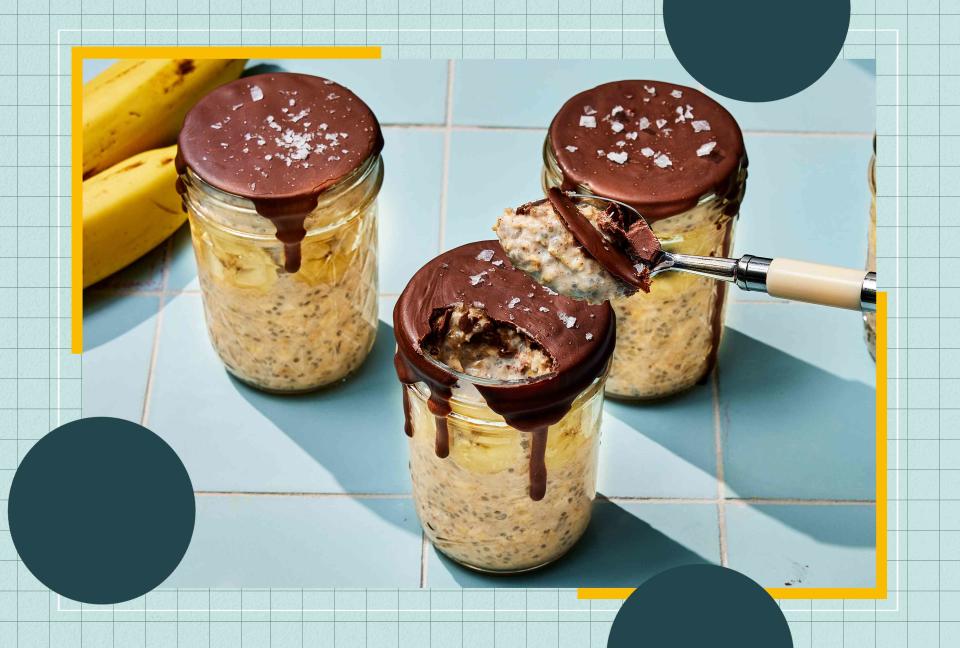The #1 Mistake You're Making with Overnight Oats, According to a Registered Dietitian
Overnight oats are a great way to start the day, but there’s a trick for getting them just right.

Photographer: Robby Lozano, Food Stylist: Nicole Hopper, Prop Stylist: Tucker Vines
Reviewed by Dietitian Annie Nguyen, M.A., RD
In my opinion, oats are seriously underrated. These humble little grains are not only extremely versatile and budget-friendly, but they’re also packed with fiber, vitamins and minerals that can help to promote heart health and lower cholesterol levels. And making overnight oats—soaking oats in liquid overnight in the refrigerator with any flavorings your heart desires—is an easy way to have a healthy breakfast ready to start your day. I love overnight oats so much that they have become my new breakfast obsession!
Related: What Happens to Your Body When You Eat Oatmeal Every Day
One of the things I love most about overnight oats is how they allow me to customize my breakfast meal to suit my taste buds and nutritional needs. I can add a variety of ingredients like nuts, fruits, seeds and even protein powder to boost the flavor and nutrient content. This versatility makes it easy to create a well-balanced and satiating meal that helps to keep me energized and satisfied until my next meal.
Even though overnight oats are easy to make, there are a few tips and tricks to making this breakfast delight just right. One of those tips includes using old-fashioned oats instead of quick-cooking oats. What’s the difference, you may ask. Well, let’s talk about it.
The Difference Between Quick-Cooking Oats & Old-Fashioned Oats
At first glance, quick-cooking oats and old-fashioned oats may seem fairly similar, but their differences lie in their processing methods. Quick-cooking oats undergo further processing, which results in smaller and thinner flakes, while old-fashioned oats undergo minimal processing and retain their thicker texture. This variation in texture not only affects the appearance of the oats but also influences how they cook (or in this case, soak) and the final consistency of your overnight oats.
From a nutrition standpoint, both types of oats offer similar benefits in terms of vitamins, fiber and minerals, according to the USDA. However, old-fashioned oats are considered slightly healthier due to their less processed nature and slightly lower glycemic index. Old-fashioned oats are digested more slowly, resulting in a gradual rise in blood sugar levels rather than a sudden spike. As a result, these oats provide longer-lasting energy and help maintain stable blood sugar levels.
Why You Should Use Old-Fashioned Oats to Make Overnight Oats
When making overnight oats, old-fashioned oats are the best choice. When soaked in liquid overnight, these oats soften but retain their sturdy texture, which complements the creamy base of the overnight oats. In contrast, quick-cooking oats can become mushy and lose their distinct texture, resulting in a less appealing finished product and breakfast experience.
Another reason why old-fashioned oats are a great choice is because they absorb liquid more gradually, ensuring that your overnight oats achieve the ideal thickness without becoming too watery. This also yields a well-balanced and creamy consistency that is both comforting and satisfying.
How to Make the Best Overnight Oats
Creating the perfect batch of overnight oats doesn’t require a ton of effort or time, just a few simple ingredients. Simply start by combining ½ cup of old-fashioned oats with ½ cup of milk in an airtight container or mason jar. You can choose to use dairy or nondairy milk. For added creaminess and an added source of protein, stir in ¼ cup of strained (Greek-style) yogurt. You can also add in a tablespoon of chia seeds or flaxseeds for extra thickness and nutritional benefits. Sweeten your oats with a drizzle of honey, agave or maple syrup to your specific taste preference.
Related: 12 Overnight Oat Recipes That Taste Like Dessert For Breakfast
For the finishing touch, add your favorite toppings and/or flavorings. If you’re feeling a little fruity, try adding in some sliced bananas, berries or diced peaches. If you’re a nut lover, sprinkle in a few chopped walnuts, almonds or a dollop of peanut butter. For a fragrant aroma and an extra boost of flavor, try adding in a few spices such as cinnamon, nutmeg or a dash of vanilla extract. You can also experiment with shredded coconut, dried fruit or granola for added texture and crunch. When you’re done customizing your oats, cover your jar or container with a lid, and refrigerate overnight. The next morning, you’ll wake up to a delicious and nutritious breakfast that can be enjoyed cold or warm.
Bottom Line
Overnight oats are a great way to start the day. They’re convenient, nutritious and easy to make. To make the best overnight oats, opt for old-fashioned oats over quick-cooking oats. While both varieties of oats offer similar nutritional benefits, old-fashioned oats have a thicker texture and consistency, which allows them to retain their chewiness even after soaking overnight, resulting in a creamy, hearty base for a variety of toppings and flavorings. Old-fashioned oats are also a great choice for those looking to manage their blood sugar levels, due to their slightly lower glycemic index.
Read the original article on Eating Well.

